|
|
|
Sort Order |
|
|
|
Items / Page
|
|
|
|
|
|
|
| Srl | Item |
| 1 |
ID:
118311
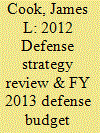

|
|
|
|
|
| Publication |
2013.
|
| Summary/Abstract |
Regardless of whether one is a supporter or a critic, some additional analysis regarding the formulation of the new defense strategic guidance is useful to better understand the rationale for changing defense priorities, the magnitude and impact of these changes within the Department of Defense (DOD), and the review process itself. Specifically, three questions warrant further examination: 1) Why was a DoD-level defense strategy review necessary, given the 2010 Quadrennial Review? 2) What are the implications of this new strategic guidance for the DoD? 3) What are the strategic risks? These questions are addressed by assessing the defense strategic guidance through the lens of strategy and its components: ends, ways, means and risk.
The United States of America is the greatest force for freedom and security that the world has ever known. And in no small measure, that's because we've built the best-trained, best-led, best-equipped military in history - and as Commander-in-Chief, I'm going to keep it that way.
|
|
|
|
|
|
|
|
|
|
|
|
|
|
|
|
| 2 |
ID:
150090
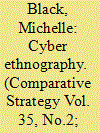

|
|
|
|
|
| Summary/Abstract |
There seems to be a current push for intelligence to be more informed through sociocultural analysis. This article argues that a new variation of ethnography, cyber ethnography, is the answer to calls for additional support, and should be incorporated into the Department of Defense (DoD) methodological “tool box.” This article answers: What is cyber ethnography and how could it contribute to United States defense work? What are some of the method's limitations and challenges, especially when performed by DoD personnel? At the same time, what type of community could be studied by the DoD using cyber ethnography? And finally, what are the requirements to perform this method?
|
|
|
|
|
|
|
|
|
|
|
|
|
|
|
|
| 3 |
ID:
150449


|
|
|
|
|
| Summary/Abstract |
The Department of Defense (DOD) is the major consumer of energy within the Federal government, and it has been directed to implement cost cutting measures related to energy dependence through numerous Executive Orders and Congressional legislation. As a result, the DOD released an Energy Strategy which outlines ways to reduce energy requirements in order to meet both Presidential and Congressional mandates for energy security. With this research, we provide a historical review (1973–2014) of energy policy, legislation, and research. Additionally we identify gaps between strategy and research. The results show that DOD energy research lacks a unifying structure and guiding framework. We propose a knowledge management framework to unify and guide research efforts in direct support of the DOD Energy Strategy.
|
|
|
|
|
|
|
|
|
|
|
|
|
|
|
|
| 4 |
ID:
099515


|
|
|
|
|
| Publication |
2010.
|
| Summary/Abstract |
In his 2009 Prague speech and the 2010 Nuclear Posture Review, President Barack Obama committed the United States to take concrete steps toward nuclear disarmament while maintaining a safe, secure, and effective nuclear deterrent. There is an inherent tension between these two goals that is best addressed through improved integration of nuclear weapons objectives with nuclear arms control objectives. This article reviews historical examples of the interaction between the two sets of objectives, develops a framework for analyzing opportunities for future integration, and suggests specific ideas that could benefit the nuclear weapons enterprise as it undergoes transformation and that could make the future enterprise compatible with a variety of arms control futures.
|
|
|
|
|
|
|
|
|
|
|
|
|
|
|
|
| 5 |
ID:
116066
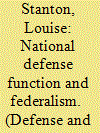

|
|
|
|
|
| Publication |
2012.
|
| Summary/Abstract |
Countries with a federalist system of government have different arrangements for providing national security. US national security is provided by national and State defense forces. The quintessential national function - national defense - experienced some changes that enhanced the role of the States. Policy changes in the National Defense Authorization Act of 2008 (2008 NDAA) introduced new roles for the Governors and the State defense forces, or the National Guard. This article explores how the interests of Congress and States aligned in the 2008 NDAA such that the national defense function changed. This article finds that the national government continues to have the central coordinating role, but that the politics and provisions of the 2008 NDAA changed the national-State relationship in mission, decision-making, and command and control so that US federalism in the national defense function is evolving in unexpected ways.
|
|
|
|
|
|
|
|
|
|
|
|
|
|
|
|
| 6 |
ID:
086341
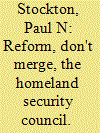

|
|
|
|
|
| Publication |
2009.
|
| Summary/Abstract |
A growing number of scholars argue that the new administration should overturn a key decision made by President George W. Bush: his creation in 2002 of a Homeland Security Council (HSC). Until the September 11, 2001 attacks, the National Security Council (NSC) coordinated the handful of institutions (including the Department of Defense (DOD)) that protected the United States from its adversaries. Bush responded to Al Qaeda's attacks by organizing a sprawling parallel system of institutions to protect the United States from terrorism. The Department of Homeland Security (DHS) is only part of that system. The Bush administration also assigned terrorism prevention functions to the Departments of Agriculture (USDA), Health and Human Services, Interior, and other federal institutions which had never before played such significant roles in securing the United States from attack. Bush capped this parallel security system with the HSC to help guide and coordinate its activities.
|
|
|
|
|
|
|
|
|
|
|
|
|
|
|
|
| 7 |
ID:
137937
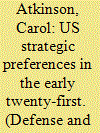

|
|
|
|
|
| Summary/Abstract |
This article investigates how US national security planners have envisioned the emerging strategic environment during the early twenty-first century and evaluates how their perceptions of this strategic environment have changed during these years. This conceptual evolution can be seen in how defense planners define threats, identify defense priorities, and design security strategies. Five key strategic planning documents serve as the basis for this analysis and illustrate significant shifts in how the US government has envisioned its own security requirements as well as the context within which its strategic vision will need to be realized. These planning documents are: (1) Joint Vision 2020, (2) the Bush Administration’s 2002 National Security Strategy of the United States, (3) the Obama Administration’s 2010 National Security Strategy, (4) US Strategic Defense Guidance entitled Sustaining US Global Leadership: Priorities for 21st Century Defense, and (5) the US Chairman of the Joint Chiefs of Staff’s Capstone Concept for Joint Operations: Joint Force 2020.
|
|
|
|
|
|
|
|
|
|
|
|
|
|
|
|
|
|
|
|
|